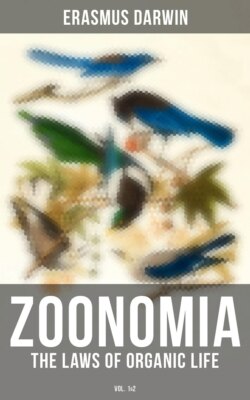Читать книгу Zoonomia - The Laws of Organic Life (Vol. 1&2) - Darwin Erasmus - Страница 12
На сайте Литреса книга снята с продажи.
SECT. VI.
OF THE FOUR CLASSES OF FIBROUS MOTIONS.
ОглавлениеTable of Contents
I. Origin of fibrous contractions. II. Distribution of them into four classes, irritative motions, sensitive motions, voluntary motions, and associate motions, defined.
I. All the fibrous contractions of animal bodies originate from the sensorium, and resolve themselves into four classes, correspondent with the four powers or motions of the sensorium above described, and from which they have their causation.
1. These fibrous contractions were originally caused by the irritations excited by objects, which are external to the moving organ. As the pulsations of the heart are owing to the irritations excited by the stimulus of the blood; and the ideas of perception are owing to the irritations excited by external bodies.
2. But as painful or pleasurable sensations frequently accompanied those irritations, by habit these fibrous contractions became causeable by the sensations, and the irritations ceased to be necessary to their production. As the secretion of tears in grief is caused by the sensation of pain; and the ideas of imagination, as in dreams or delirium, are excited by the pleasure or pain, with which they were formerly accompanied.
3. But as the efforts of the will frequently accompanied these painful or pleasureable sensations, by habit the fibrous contractions became causable by volition; and both the irritations and sensations ceased to be necessary to their production. As the deliberate locomotions of the body, and the ideas of recollection, as when we will to repeat the alphabet backwards.
4. But as many of these fibrous contractions frequently accompanied other fibrous contractions, by habit they became causable by their associations with them; and the irritations, sensations, and volition, ceased to be necessary to their production. As the actions of the muscles of the lower limbs in fencing are associated with those of the arms; and the ideas of suggestion are associated with other ideas, which precede or accompany them; as in repeating carelessly the alphabet in its usual order after having began it.
II. We shall give the following names to these four classes of fibrous motions, and subjoin their definitions.
1. Irritative motions. That exertion or change of the sensorium, which is caused by the appulses of external bodies, either simply subsides, or is succeeded by sensation, or it produces fibrous motions; it is termed irritation, and irritative motions are those contractions of the muscular fibres, or of the organs of sense, that are immediately consequent to this exertion or change of the sensorium.
2. Sensitive motions. That exertion or change of the sensorium, which constitutes pleasure or pain, either simply subsides, or is succeeded by volition, or it produces fibrous motions; it is termed sensation, and the sensitive motions are those contractions of the muscular fibres, or of the organs of sense, that are immediately consequent to this exertion or change of the sensorium.
3. Voluntary motions. That exertion or change of the sensorium, which constitutes desire or aversion, either simply subsides, or is succeeded by fibrous motions; it is then termed volition, and voluntary motions are those contractions of the muscular fibres, or of the organs of sense, that are immediately consequent to this exertion or change of the sensorium.
4. Associate motions. That exertion or change of the sensorium, which accompanies fibrous motions, either simply subsides, or is succeeded by sensation or volition, or it produces other fibrous motions; it is then termed association, and the associate motions are those contractions of the muscular fibres, or of the organs of sense, that are immediately consequent to this exertion or change of the sensorium.
